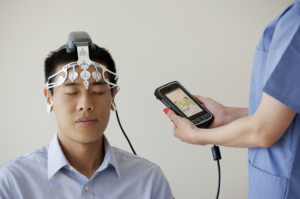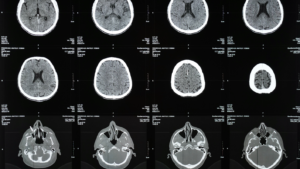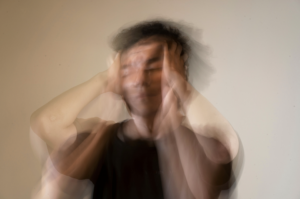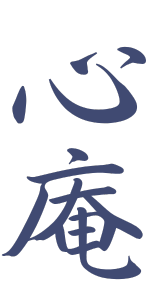Why Does the Brain Insist on Making Connections?

💡 “This event happened because of that!”
Have you ever found yourself making such assumptions?
For example:
- Seeing dark clouds before leaving the house and thinking, “It’s going to rain.”
- Hearing a particular song and instantly recalling a specific memory.
However, not all events are truly connected by cause and effect.
So, what does the brain use to determine causality?
How does it decide what is connected?
🧠 The Brain as a “Prediction Machine”

To understand the brain’s function, we must recognize one essential fact:
The brain constantly predicts the future and verifies those predictions every second.
This concept, known as Predictive Processing Theory, was proposed by Karl Friston (Friston, 2010).
For instance:
🐻 If you encounter a wild bear in the forest, your brain immediately signals,
“Run!”
👉 This response is based on past experiences and knowledge, which the brain compares to an internal “programming” to make predictions.
💡 But This System Has Flaws
One crucial point to remember is that this prediction system is often prone to errors.
People frequently fabricate causal relationships that do not exist.
🔬 Experiment: How Much Does the Brain Believe in Causality?

Dr. George Baillargeon and Dr. Andrew Hall conducted research on how our brains unconsciously perceive causality (Baillargeon et al., 1985).
🔍 Experiment Details:
- Participants were shown randomly flashing light patterns.
- Researchers observed whether the participants found meaning in these patterns.
📊 Results:
🔹 Most participants mistakenly believed that specific light patterns triggered the next flash—even though the flashes were random.
This finding highlights how adept our brains are at identifying patterns, even when none exist.
From an evolutionary standpoint, quickly identifying causal relationships was advantageous for survival.
For example:
“If I hear this sound, a predator might be nearby.”
⚠️ However, in the modern world, this same trait can lead to false beliefs and cognitive biases.
🎭 The Trap of Causality: When Assumptions Shape Reality

For example:
👕 You wear a red shirt on the day you pass an exam.
👉 You start believing, “Wearing a red shirt brings success.”
🏆 Similarly, many athletes develop superstitious routines before games based on past successes.
⚠️ Note: This is different from ”Anchoring.”
Another example:
❌ Repeated failures might lead to the belief “I am not good enough.”
👉 However, the real reason could simply be that the learning method was ineffective, not that you are incapable.
Many of these assumed cause-and-effect relationships are actually coincidences rather than true causal links.
💪 How to Strengthen Your Ability to Discern Causality

The good news is that the brain is constantly adapting—meaning we can reframe how we interpret causality.
Here are some habits to help prevent mistaken assumptions:
🔍 Question Your Assumptions
When you catch yourself thinking, “This always happens to me” or “I can never do this”, pause and ask:
👉 “Is this really true? Or is it just a pattern my brain created?”
👉 “Does a real causal relationship exist here?”
🧐 Gather Data & Explore Alternative Explanations
If something doesn’t go well, avoid jumping to the conclusion “I failed because I’m not good enough.”
Instead, ask:
👉 “Was there a better strategy I could have used?”
Rather than making a judgment based on a single experience, look at multiple instances for a broader perspective.
🌍 Create New Associations & Perspectives
Just as the brain can associate “failure = fear,” it can also learn that “effort = growth.”
Reframe mistakes as learning opportunities rather than obstacles.
Try viewing your situation from different angles:
👉 “If someone else looked at this, how would they interpret it?”
🧠 Show Your Brain New Possibilities
Each time you break old assumptions, your brain forms new neural pathways.
By taking on new challenges, you can reshape your brain’s “causality map.”
Example:
An athlete who believes “I choke under pressure” starts using visualization techniques before a game.
Gradually, their mindset shifts to: “I can handle pressure.”
Over time, this mental shift improves actual performance.
📌 Summary

Our brains are constantly seeking causal relationships.
However, these assumptions are not always correct.
To make better judgments,
we should:
✅ Question our assumptions
✅ Reevaluate our thinking patterns
✅ Distinguish facts from interpretations
✅ Explore new possibilities
Ask yourself:
💡 “Is the causal relationship I believe in actually true?”
By challenging these assumptions, you might open doors to new opportunities and a brighter future.
📚 References
-
- Baillargeon, R., Spelke, E. S., & Wasserman, S. (1985). Object permanence in five-month-old infants. Cognition, 20(3), 191-208.
- Friston, K. (2010). The free-energy principle: a unified brain theory? Nature Reviews Neuroscience, 11(2), 127-138.




コメント